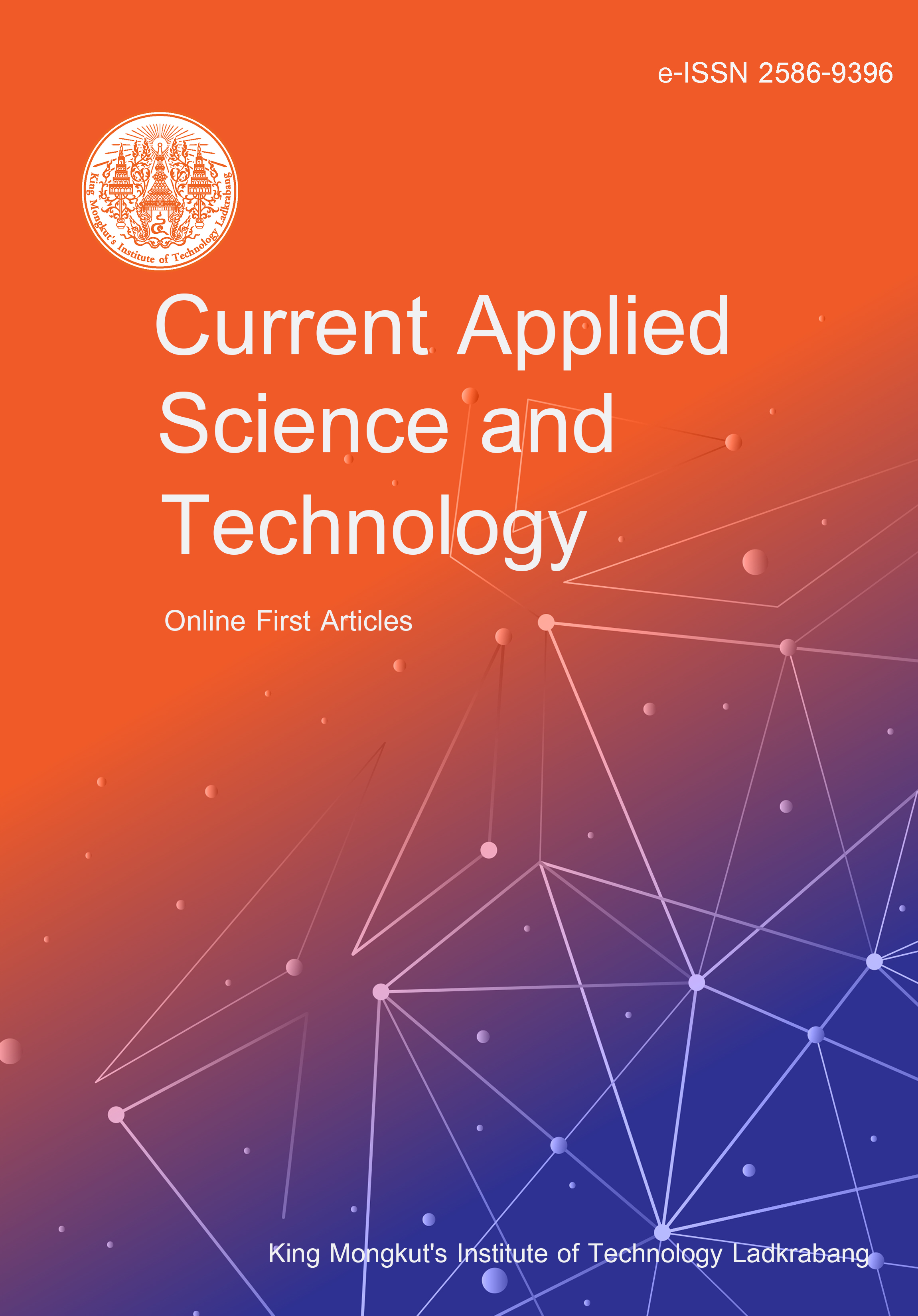Effect of Polycarbonate Sheet Color on Andrographolide Content in Andrographis paniculata (Burm.f.) Nees
Main Article Content
Abstract
The quality of dried Andrographis paniculata (Burm.f.) Nees (Fa-Talai-Jorn) is important to determine its effectiveness in traditional medicine. The present study was aimed to investigate the effect of the color of polycarbonate sheet on andrographolide content. Four colors of polycarbonate sheets (clear, green, blue, and gray) were used as covers for household solar dryers. Drying experiments of Andrographis paniculata with an initial moisture content of 85% w.b. were conducted to achieve a final moisture content of 7% w.b. by using four household solar dryers with different colors of polycarbonate sheets and natural sun drying. The andrographolide contents of the dried Andrographis paniculata samples were evaluated using the HPLC technique. The results indicated that the color of polycarbonate sheet affected andrographolide content. The highest andrographolide content of 3.40% was obtained from the solar dryer covered with gray polycarbonate sheet.
Article Details

This work is licensed under a Creative Commons Attribution-NonCommercial-NoDerivatives 4.0 International License.
Copyright Transfer Statement
The copyright of this article is transferred to Current Applied Science and Technology journal with effect if and when the article is accepted for publication. The copyright transfer covers the exclusive right to reproduce and distribute the article, including reprints, translations, photographic reproductions, electronic form (offline, online) or any other reproductions of similar nature.
The author warrants that this contribution is original and that he/she has full power to make this grant. The author signs for and accepts responsibility for releasing this material on behalf of any and all co-authors.
Here is the link for download: Copyright transfer form.pdf
References
Adeyeye, S. A. O., Ashaolu, T. J., & Babu, A. S. (2022). Food drying: A review. Agricultural Reviews, 1(8), 1-8. https://doi.org/10.18805/ag.R-2537
Chokthaweepanich, H., Chumnanka, C., Srichaijaroonpong, S., & Boonpawa, R. (2023). Effect of harvesting age and drying condition on andrographolide content, antioxidant capacity, and antibacterial activity in Andrographis paniculata (Burm. f.) Nees. AIMS Agriculture & Food, 8(1), 137-150. https://doi.org/10.3934/agrfood.2023007
Gulati, S., Pandey, A. K., & Gupta, A. (2020). Impact of drying methods on the active phytochemical constituent of Andrographis paniculata (Kalmegh). Journal of Pharmacognosy and Phytochemistry, 9(6), 96-100.
Hii, C. L., Jangam, S. V., Ong, S. P., & Mujumdar, A. S. (2012). Solar drying: Fundamentals, applications and innovations. TPR Group Publication Publishers.
Hossain, M. S., Urbi, Z., Sule, A. & Rahman, K. M. H. (2014). Andrographis paniculata (Burm. f.) Wall. ex Nees: A review of ethnobotany, phytochemistry, and pharmacology. The Scientific World Journal, 2014, Article 274905. https://doi.org/10.1155/2014/274905
Inyang, U., Oboh, I., & Etuk, B. (2017). Drying and the different techniques. International Journal of Food Nutrition and Safety, 8(1), 45-72.
Kalariya, K. A., Gajbhiye, N. A., Meena, R. P., Saran, P. L., Minipara, D., Macwan, S., & Geetha, K. A. (2021). Assessing suitability of Andrographis paniculata genotypes for rain-fed conditions in semi-arid climates. Information Processing in Agriculture, 8(2), 359-368. https://doi.org/10.1016/j.inpa.2020.09.003
Khanal, P., Dey, Y. N., Patil, R., Chikhale, R., Wanjari, M. M., Gurav, S. S., Patil, B. M., Srivastava, B., & Gaidhani, S. N. (2021). Combination of system biology to probe the anti-viral activity of andrographolide and its derivative against COVID-19. RSC Advances, 11(9), 5065-5079. https://doi.org/10.1039/d0ra10529e
Komaikul, J., Ruangdachsuwan, S., Wanlayaporn, D., Palabodeewat, S., Punyahathaikul, S., Churod, T., Choonong, R., & Kitisripanya, T. (2023). Effect of andrographolide and deep eutectic solvent extracts of Andrographis paniculata on human coronavirus organ culture 43 (HCoV-OC43). Phytomedicine, 112, Article 154708. https://doi.org/10.1016/j.phymed.2023.154708
Pholphana, N., Rangkadilok, N., Saehun, J., Ritruechai, S., & Satayavivad, J. (2013). Changes in the contents of four active diterpenoids at different growth stages in Andrographis paniculata (Burm. f.) Nees (Chuanxinlian). Chinese Medicine, 8, Article 2. https://doi.org/10.1186/1749-8546-8-2.
Saohin, W., Boonchoong, P., Iamlikitkuakoon, S., Jamnoiprom, I, & Mungdee, W. (2007). Effects of drying temperature and residual moisture content of Fa-Tha-Li (Andrographis paniculata (Burm.f.) Nees) crude powder for capsule preparation. Thai Journal of Pharmaceutical Sciences, 31, 28-35.
Saravanan, R., Krishti, S., Gajbhiye, N. A., & Maiti, S. (2008). Influence of light intensity on gas exchange, herbage yield and andrographolide content in Andrographis paniculata (Nees.). Indian Journal of Horticulture, 65(2), 220-225.
Serrano, M. A., & Moreno, J. C., 2020. Spectral transmission of solar radiation by plastic and glass materials. Journal of Photochemistry and Photobiology B: Biology, 208, Article 111894. https://doi.org/10.1016/j.jphotobiol.2020.111894
Sharma, S., Sharma, Y. P., & Bhardwaj, C. (2018). HPLC quantification of andrographolide in different parts of Andrographis paniculata (Burm. f.) Wall. ex Nees. Journal of Pharmacognosy and Phytochemistry, 7(3), 168-171
Soltani, A., Jaam, M., Nazar, Z., Stewart, D., & Shaito, A. (2023). Attitudes and beliefs regarding the use of herbs and supplementary medications with COVID-19: A systematic review. Research in Social and Administrative Pharmacy, 19(3), 343-355. https://doi.org/10.1016/j.sapharm.2022.11.004
Srikanth, L., & Sarma, P. V. G. K. (2021). Andrographolide binds to spike glycoprotein and RNA-dependent RNA polymerase (NSP12) of SARS-CoV-2 by in silico approach: a probable molecule in the development of anti-coronaviral drug. Journal of Genetic Engineering and Biotechnology, 19(1), Article 101. https://doi.org/10.1186/s43141-021-00201-7
Tummanichanont, C., Phoungchandang, S., & Srzednicki, G. (2017). Effects of pretreatment and drying methods on drying characteristics and quality attributes of Andrographis paniculata. Journal of Food Processing and Preservation, 41(6), Article e13310. https://doi.org/10.1111/jfpp.13310
Tummanichanont, C., Srzednicki, G., & Phoungchandang, S. (2018). Changes of bioactive compounds during storage of dried Andrographis paniculata leaves after drying using different methods. Khon Kaen Agriculture Journal, 46(3), 601-612.
Wang, Z., Ban, J., Wang, H., Qie, R., & Zhou, Y. (2024). Deciphering the mechanism of Ephedra Herba-Armeniacae Semen Amarum herb pairs on COVID-19 by integrated network pharmacology and bioinformatics. Arabian Journal of Chemistry, 17(2), Article 105540. https://doi.org/10.1016/j.arabjc.2023.105540
Ye, L., Fan, S., Zhao, P., Wu, C., Liu, M., Hu, S., Wang, P., Wang, H., & Bi, H. (2023). Potential herb‒drug interactions between anti-COVID-19 drugs and traditional Chinese medicine. Acta Pharmaceutica Sinica B 13(9), 3598-3637. https://doi.org/10.1016/j.apsb.2023.06.001





